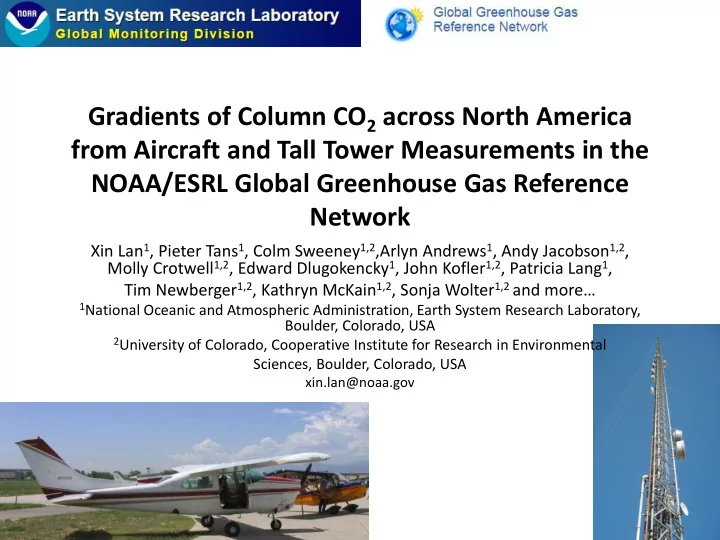

Gradients of Column CO 2 across North America from Aircraft and Tall Tower Measurements in the NOAA/ESRL Global Greenhouse Gas Reference Network Xin Lan 1 , Pieter Tans 1 , Colm Sweeney 1,2 ,Arlyn Andrews 1 , Andy Jacobson 1,2 , Molly Crotwell 1,2 , Edward Dlugokencky 1 , John Kofler 1,2 , Patricia Lang 1 , Tim Newberger 1,2 , Kathryn McKain 1,2 , Sonja Wolter 1,2 and more… 1 National Oceanic and Atmospheric Administration, Earth System Research Laboratory, Boulder, Colorado, USA 2 University of Colorado, Cooperative Institute for Research in Environmental Sciences, Boulder, Colorado, USA xin.lan@noaa.gov
(ACP, 2014 ) Multi-year(2003-2010) June-August averaged satellite-retrieved XCO2 (SCIMACHNY and GOSAT), calculated from annual seasonal anomalies in order to minimize effects due to different annual samplings. Gridded to a regular 2⁰ × 2⁰ grid and smoothed with a Hann function with 5⁰ × 5⁰ effective width.
1 ETL 2 ESP DND LEF 4 MBO BGI FWI 5 HFM NHA WBI OIL THD CAR BNE AAO HIL 6 CMA WGC 3 SGP MWO WKT 7 TGC Aircraft measurements: normally conducted at late morning to early afternoon. Flask samples were collected up to 8km.
Time series of aircraft and tower data Aircraft (in red, data above 2km is in black) and tower data(in blue) at 10:00-17:00 Local Standard Time. Yellow solid line shows the trend curve calculated from Mauna Loa site.
Long-term mean gradients at different vertical layers < 2km 2-5km 5-8 km Very little gradients >8km above 8km, which also (CarbonTracker) 1 2 imply that adding these 4 data for XCO2 calculation 5 3 6 is not going to introduce 7 larger spatial gradients than the partial XCO2.
Daily profiles Column averages (pressure weighted) are calculated using a trapezoidal integration method. Time series of partial XCO 2 calculated from each daily profile.
Long-term mean vertical profiles • We used tower data at highest in-take level. • Only days with aircraft measurements were selected from tower data. • Tower data fit well in long-term monthly vertical profiles.
Long-term mean monthly column average (partial XCO 2 ) Partial XCO2 calculated from aircraft & tower data (left) and CarbonTracker modeled data(right, note that aircraft profiles were not assimilated in CarbonTracker). Same sites are selected for comparison. CarbonTracker evaluation: http://www.esrl.noaa.gov/gmd/ccgg/carbontracker/profiles.php
Total XCO 2 1 2 4 5 3 6 7 June to August Avg. The long-term mean June to August drawdowns at the northern regions are stronger by ~ 3ppm than the southern regions.
Long-term mean Jun. to Aug. CarbonTracker vs Aircraft XCO 2 Aircraft XCO 2 : CT data from upper layers are used with aircraft data.
Long-term mean Jun. to Aug. wind vector Pressure-weighted column mean wind(1000-500hPa). Wind data are from NCEP/NCAR Reanalysis.
Long-term mean Jun. to Aug. CarbonTracker XCO 2 (Reuter et al., 2014)
Conclusion The largest spatial gradients of CO 2 across North America appear below • 2km during summer time, while upper layer data (above 5km) show little contribution to spatial gradients. Large spatial gradients of long-term mean XCO 2 mainly occurred during • June to August with strong summer drawdowns. The long-term mean summer drawdowns at the northern regions are • stronger by ~ 3ppm than the southern regions. XCO 2 pattern does not reflect surface sources and sinks directly. Instead, it • reflects the large-scale circulation. xin.lan@noaa.gov
Supporting Materials
Code Name Latitude Longitude Site Elevation(masl) Top Altitude(masl) Time start Time end AAO Airborne Aerosol Observing 40.050 -88.370 230 4572 06/07/2006 09/18/2009 BGI Bradgate, Iowa 42.820 -94.410 355 7620 09/13/2004 11/18/2005 BNE Beaver Crossing, Nebraska 40.800 -97.180 466 8120 09/15/2004 05/11/2011 CAR Briggsdale, Colorado 40.635 -104.327 1488 8410 11/09/1992 Ongoing CMA Cape May, New Jersey 38.830 -74.320 0 7620 08/17/2005 Ongoing DND Dahlen, North Dakota 47.500 -99.240 472 8131 09/21/2004 Ongoing ESP Estevan Point, British Columbia, Canada 49.383 -126.544 7 5695 11/22/2002 Ongoing ETL East Trout Lake, Saskatchewan, Canada 54.350 -104.983 492 7228 10/15/2005 Ongoing FWI Fairchild, Wisconsin 44.660 -90.960 334 7620 09/20/2004 11/18/2005 HFM Harvard Forest, Massachusetts 42.538 -72.171 340 7620 11/11/1999 11/18/2007 HIL Homer, Illinois 40.070 -87.910 202 8059 09/16/2004 Ongoing LEF Park Falls, Wisconsin 45.945 -90.273 472 5060 04/10/1998 Ongoing LEF Park Falls, Wisconsin (Tower) 45.945 -90.273 472+396 NA 08/01/2003 Ongoing MBO Mt. Bachelor Observatory(Tower) 43.977 -121.686 2731+11 NA 10/14/2011 Ongoing MWO Mt. Wilson Observatory (Tower) 34.225 -118.059 1728 NA 04/30/2010 Ongoing NHA Worcester, Massachusetts 42.950 -70.630 0 7620 09/12/2003 Ongoing OIL Oglesby, Illinois 41.280 -88.940 192 7620 09/16/2004 11/19/2005 SGP Southern Great Plains, Oklahoma 36.607 -97.489 314 5330 09/17/2002 Ongoing TGC Sinton,Texas 8107 Ongoing 27.730 -96.860 0 09/09/2003 THD Trinidad Head, California 41.054 -124.151 107 7953 09/02/2003 Ongoing WBI West Branch, Iowa 41.725 -91.353 242 8073 09/14/2004 Ongoing WBI West Branch, Iowa (Tower) 41.725 -91.353 241.7+379 NA 06/28/2007 Ongoing WGC Walnut Grove, California(Tower) 38.265 -121.491 0+483 NA 09/20/2007 Ongoing WKT Moody, Texas (Tower) 31.315 -97.327 251+457 NA 07/11/2003 Ongoing
Long Term Average Monthly Vertical Profiles
Long-term mean monthly vertical profiles
Uncertainty from aircraft & tower data Method : Bootstrap-Monte Carlo (100 runs), random selections of daily profiles. No limits on repetition.
Long-term mean Jun. to Aug. wind vector whole column
Long-term mean Jun. to Aug. wind vector 1000-500hPa
Long-term mean Jun. to Aug. wind speed 1000-500hPa
Long-term mean Jun. to Aug. wind vector 1000-500hPa
Recommend
More recommend